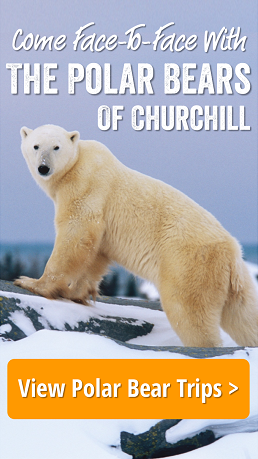by Steve Selden | Dec 16, 2010 | Tour News
Snow accumulating up to 15cm (just over five inches) over the next few days will give the region a little more of a Winter look… contrary to the feel Churchillians are getting from the continued “warmer” air temperatures that have returned once more. Temperatures are now hovering just below the freezing mark with not a whole lot of existing snow- cover. Although the wind-chill surely won’t allow for tee shirts and shorts, nobody seems to be complaining about the October-like reprieve.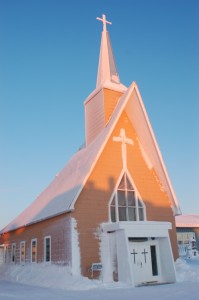
Local Dene elder Caroline Bjorklund was out riding around with a friend and they came across an arctic hare scampering around the outskirts of town. A few foxes, of the red and arctic variety, also were out looking to take advantage of the shallow snow cover and store up some last energy morsels before the inevitable turn to true Winter conditions. Although polar bears have not been spotted recently, Caroline and friend saw some fresh paw tracks just near the grain elevator at the port.
The relationship between bears and people in Churchill is truly a strange, dichotomous one. Without polar bears the town would surely be quite different…..and, although locals by and large are not big polar bear lovers due to the safety risk, the bears seem to be the heart and soul of the town. When they are mostly gone in late November, stories of finding fresh tracks or hearing Manitoba Conservation cracker shells echo in the distance ring like forlorn tales of lost friends. After all, the two month focus on polar bears surely is exciting and once done the void seems great. The sensation one feels after losing a limb…feeling the appendage is still there…is probably not an apt analogy but I think you get the idea, eh?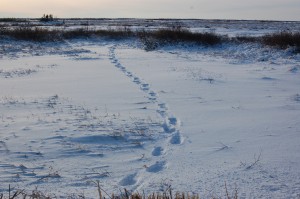
The Churchill Northern Studies Center is nearing the completion of its’ massive reconstruction project way out East at the end of the highway. A new state of the art research and housing facility is hoped to be finished by Spring.The building looks like a grounded “Noah’s Arc” according to Caroline Bjorklund and other locals. I guess if global warming accelerates considerably in the future, Churchillians and the researchers will all be in the same “boat”. Now that would be some reality series.
The Northern Studies Center and Parcs Canada are conducting a science symposium in Winnipeg on January 19-21, 2011. Each year the Churchill Northern Studies Centre hosts a Research Symposium in southern Manitoba and every other year Parks Canada hosts a Wapusk National Park Research and Monitoring Meeting. This year the two have joined together to present a CNSC-PC two day science symposium. It will be a platform for researchers to present and discuss ongoing and completed projects worked on this past year. For more details go to the center’s website at churchillscience.ca.
by Steve Selden | Dec 9, 2010 | Tour News
Where else in the world do polar bears get freed from “jail” as soon as enough ice forms on a body of water bigger than Texas? Kind of crazy when you think about it, eh? 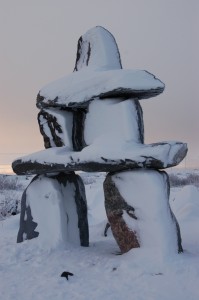
Well that’s what happened this past week as the last of the furry inmates were trucked down to the edge of the Hudson Bay by Manitoba Conservation officers and released to go on their way and find lots and lots of yummy seals in snowy dens. The last five made there way onto the ice , disappearing out of sight as they blended into the gray and white of the horizon.
Some days the ice in the bay breaks from the land -fast ice and is pushed by the wind farther into the bay leaving a mammoth lead of open water. This will occur for some time until the majority of the bay succumbs to the frigid North winds filled with icy air. Then huge pressure ridges will rise and fall as ice – plates methodically collide with each other. These ridges, once formed allow for shelter for bears, foxes and seals when the going gets rough…
Random bears were still being sighted around town, perhaps just not quite ready to cut that final tie to Churchill…kind of a surrogate mother of sorts with all the interesting aromas and goodies…mostly around L5..otherwise known as the garbage …uh um…recycling center. A pesky smaller bear was sighted almost every day for the last week behind the town complex….just hanging onto the last days of bear season. The season officially ends when local Churchillian’s can feel somewhat at ease when venturing from their homes without the prevalent feeling of danger nearby. Pretty much by that time it’s too cold to do much venturing anyway…in somewhat of an ironic twist, some locals have their own version of hibernation at that point.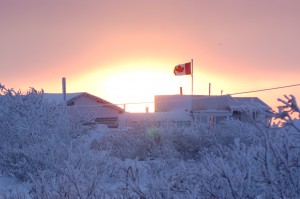
Temperatures are right in the mid 30’s C and Friday’s wind chill is expected to be about -52 C….hibernation sounds good to me!
by Steve Selden | Nov 25, 2010 | Tour News
On perfect cue, the arctic freeze settled into the Churchill Region just as widespread panic (not the musicians) started to surface in the media. True, the Hudson Bay was pretty much ice-free up until a week ago…but it always seems to find a way to freeze just about the same time every year. In most recent years it seems everyone has been panicking in the other direction with hopes that the bay doesn’t freeze too quickly so that the polar bears don’t evacuate the land before all travelers/photographers get good sightings. The Spring ice break-up has surely been more of a harbinger in the global warming debate. Let’s hope that there is enough ways for polar bears to adapt to the changes of more time on land due to a shortened season of seal hunting on the ice. I’m optimistic.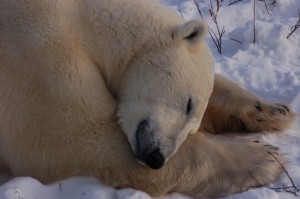
During the last few days of the tundra lodge being occupied with a group of photographers led by guides Rinie and Eric, they experienced the firsthand transition of the Hudson Bay freezing sufficiently to allow the polar bears in the area to venture out of sight onto the ice. Even on some helicopter excursions, only four bears were seen out around Cape Churchill…a sure sign that secure ice is almost there. The temperature, as we know, dropped suddenly to minus 27 Celsius with biting northerly winds so quickly that, in the course of less than a week, the ice platform extended into the bay as far as the eye could see. However the group was fortunate in experiencing ample sparring due to the cold ….encouraging bears to become extremely active. A sparring party of three bears together along the coast on the sea ice enthralled the photographers in the perfect, soft light of the morning. Seemingly a choreographed farewell on the edge of their new home for the next several months. Back around the lodge two arctic foxes visited on a regular basis and one day a Canada Goose landed quite close to the lodge and looked around as if it was thinking “which way is south”? All those cameras clicking away around him may have given him reason to try and extend his fame just a little longer. We all know Canada geese are so vain….I can’t stand it.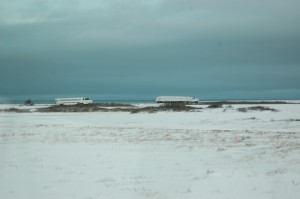
Throughout the week the lighting for the avid group of photographers was “perfect” according to both Rinie and Eric. Sunrises and sunsets generated a multitude of colorful shades of pinks, oranges and vibrant reds. More sun this week than any stretch of the entire season. A last night of stellar aurora borealis also seemed some sort of grand finale to the strange season. There is a certain feel to the end of the polar bear season in Churchill that transcends words and even photo’s…just a feel ..a blend of ending with beginning…”frozen” time.
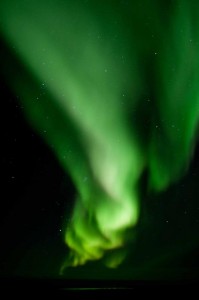
Photo: Colby Brokvist
Sleeping polar bears along the coast seemed content and reassured now that the ice would once again form in the Hudson Bay. Content that another season of age old rituals had somehow been rewarded with another Winter of assured sustenance. Happy Thanksgiving everyone!
by Steve Selden | Nov 19, 2010 | Tour News
A partly cloudy morning gave way to bright sunshine in the early afternoon while temperatures stayed below zero. Wind chills were recorded at about -24F. Ice continues to form at a rapid pace allowing polar bears freedom to test the land-fast ice building along the coast. All the fresh water pouring from the Churchill and Seal River’s freezes rapidly when dumped into the bay. Huge ice chunks forming mini bergs in the rivers are ferried out when the tide turns.. creating a log jam along the coast. Water between the chunks freezes and binds them together initiating a patchwork -like platform extending into the Hudson Bay.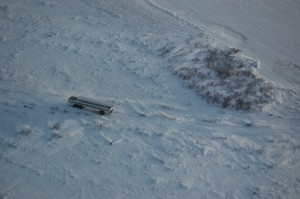
Travelers with Guide Scott witnessed this happening early in the day as they moved toward the coast in the CWMA. On the way a lone male passed by as they traveled the inland road toward Halfway Point. Two arctic foxes frenetically searched for lemmings, noses to tundra, all around the parked rover. Scanning the coastal tidal zone out past the point, the group viewed many bears tentatively stepping on the freshly formed surface. One stubborn bruin moved with reckless abandon and continually plunged through ice into the icy water. I have seen this before myself….incredibly mesmerizing to watch. Goose bumps every time the bear crashes through.
Later in the morning the bears began moving inland from the coast. As Scott’s folks enjoyed some coffee close to the tundra lodge, a couple of younger bears were near the rover curious though tentative. Just about noon many big males wandered into the area, pushing each other around with dominance tests. A couple of scrappy three and a half year old bears herded each other around under the lodge. These 700lb scarred males were growling incessantly while they kicked at and chased each other back and forth from the position underneath. One of the big boys came up to the rover and stood up to just under the back railing around the deck Scott kept an eye on his travelers ..not allowing them too close to the rail. Bears love finger food.
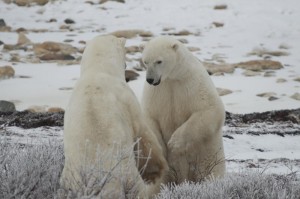
Photo: Paul Brown
As the afternoon continued, a group of five large males gathered in the distance by some willows and began to play-fight. They were paired off now just 10-15 meters off the back grate as the rover was able to position more closely. At times the sparring got pretty serious with hard, aggressive shoves into each others’ chest. The action there was accentuated by full light from the emerging sun and a good three hours of amazing viewing was enjoyed by all.
Leaving the tundra the group could see more bears out along the ice edge again this time bathed in the orange glow of another amazing sunset.
Guide Leah, out and about on the tundra with her group, sighted a few bears but most were resting in and around the willows against the lakes in the snow drifts. They also were noticing numerous bears along the coast testing the ice surface.
As we know the seal population has been doing strange things this season. Aside from stranding themselves in the intertidal zone at low tide earlier in the season, one bearded seal was found about two miles inland wandering along down an access road.
Some exciting information related to these occurrences has come to light. Orca whales (killer whales) have been seen recently in the bay; possibly accounting for the strange suicidal seals on land. Having guided 11 seasons of Churchill Summer whale tours, I have only heard rumors of one other Summer sighting of orca’s in the bay and never of any Fall sightings. . Exciting news indeed.
Guide Brent and his band of photographers were having a great day on the land. First thing out from launch they had an incredible photo opportunity as a large bear burst out of self -constructed snow cave in a huge drift of snow just by the side of the trail. The bruin rose up, wandered a bit , then returned to the cave and reclined facing out with crossed paws. I think there actually was some drooling going on aboard the rover.
The remainder of the day was all gravy after this experience and with the fantastic light the gravy was pretty tasty. Getting images of bears along the coast testing their footing highlighted by all the patterns and blues and gray’s of the snow -covered tundra all made for another successful session.
The bright orange sun globe melted into the horizon as polar bears continued to roam the coast with intensified expectations….seals oh seals where are you today?
by Steve Selden | Nov 18, 2010 | Tour News
The predicted blizzard never really materialized though some light snow fell during the day. Frigid temperatures crept in to the region as the mercury dropped to -15 to -20c with the wind chill at -34c. With this trend predicted to continue it should allay some of the panic of those speculating that the polar bears are in grave danger do to late freeze up of the Hudson Bay. True story according to the Canadian Ice Service, a division of Environment Canada. Ice formation in the Hudson Bay is about three to four weeks behind schedule due to higher temperatures. This year is the lowest ice level since 1971 although over the last five to six years the level is “not significantly different” according to Canadian Ice Service forecaster Luc Desjardins. The difference this season has been the higher temperatures. In Nunavut’s Foxe Basin to the North the air temperature is 14 degrees above normal and overall the temperature in the Bay itself is 4 degrees above normal. Funny how those darn air temperatures affect ice formation….genius.
Don’t despair just yet. Do know that the average freeze -up in the Hudson Bay comes on November 25. That being the water from Seal River along the coast to York Factory being 50% ice-covered as viewed via satellite. And yes, this year being good deal behind that schedule, ice can form quite quickly with prolonged intense cold. Of the 12 plus years I have been working in Churchill, the fear at this time of year has been ,by and large, of an early freeze-up before all scheduled travelers were able to see the polar bears before the bears journeyed to the ice in search of seals. Each year can be different and we will surely keep an eye on the ice formation in the next few weeks and keep you informed. For now the good news is that a recent survey of 333 bears along the Western Hudson Bay has them in relatively good condition…let’s hope they stay that way until the ice forms.
Due to the frigid cold, wildlife sightings dropped off on the land. In the CWMA, guide Melissa and group struggled to find much animal action from their heated rover. Polar bears hunkered down in the willows seeking shelter from the frosty, biting wind. Even a few ptarmigan were seen burying themselves in snowdrifts to keep warm and away from stinging ice crystals blowing across the tundra. A lone bear was spotted crossing an icy thermakarst ..then lying down and rolling a bit before continuing on toward shelter. Still..the arctic feel is quite an experience to behold.
Guide Scott and group had a similar day as they perused the tundra. The weather itself can be quite scintillating if looked at the right way. Scott summed up the polar bear mentality quite nicely by stating; “If I was a polar bear I’d be sitting in the willows as well”. Well said.
Guide Brent, with his photo group, found the weather to be an opportunity for some rather unique images. Photographers do have the unique ability to see beauty in just about any kind of environmental conditions. Moving away from launch in the CWMA, the group did sight a couple of ghost-like bears moving in the distance. As they neared the bay, the predominant feature presenting itself was the ice forming almost before their eyes over a short period of time. One could actually notice the grease ice thickening and the slush ice coagulating throughout the day. This black ice phenomenon happens at a rapid pace and if the temperatures remain this low, sheet ice will follow.
The excitement of the day for the group came when they witnessed a sow with a three -year old cub charge a young male out on some pond ice…chasing him off at least four times. The male looked to be near the same age and Brent and his rover driver Rick were thinking that he could possibly be her other cub that she was attempting to wean in order to care more efficiently for the other one. Pretty interesting behavior not seen very often.
Passing by the tundra lodge on the way to Christmas Lake esker, two bears were camped out in a snowdrift. When the rover rumbled up close, the two rose, shook the snow from their heavy fur and moved around a bit..then back to cover out of the wind. Out along the rise of the esker, the photographers clicked away at the snow -blasted spruce forest as the unique patterns of the drifting snow were endless. A raven solemnly watched from the shelter of a thick spruce as the rover passed by. Forever more.
Low visibility from blowing snow crystals eliminated any sense of horizon and the scale of ghost rovers appearing out of the haze threw off one’s perspective. Sometimes they appeared as huge machines and other times quite small…a moon-like scene.
As the group made the trip back to launch, a beautiful sunset filtered through the blowing curtain of snow and ice crystals. The concentric rings of what looked like a giant orange jaw breaker gave the snow a blue tinge and highlighted the flag-like spruce trees. A warm glow in the frigid twilight of the North.
by Steve Selden | Nov 17, 2010 | Tour News
On a beautiful, calm day the sun struggled to come out…then finally relented as the temperatures dropped from -5c to -15c throughout the day and the wind started slowly and blowing ground snow signaled the start of another incoming storm predicted for later this evening.
Guide Amy and group enjoyed their last day on the tundra and came away feeling elated from the experience. Most of their time was spent near the tundra lodge where a sow with two coy’s were watched for awhile and three males playfully spent an hour around the rover. Not really sparring – they were just rolling around on the tundra like kittens….very big, very dangerous kittens…that could kill a human. Lasting photos, videos and memories were made here.

Photo: Paul Brown
On the way back to launch the group stopped by Bird Cove. They discovered one young polar bear on the leeward side of the rocky ridge, burrowed in, slowly being covered with snow. Watching this incredibly strong, dangerous animal lying under the soft, falling snow is quite the sight.
Half a mile from the launch the group got their first look at a flock of ptarmigan with their stunning white coats against the equally stunning white snow covering the tundra.

Photo: Paul Brown
Meanwhile guide Leah, off the tundra lodge for the first time this season, had her band of travelers out between Gordon Point and first tower. Several sub-adult males approached the rover and curiously sniffed footwear through the grated back observation deck. At Gordon Point, an arctic fox hunkered down on the coastline oblivious to the photographs being taken. Grease ice starting to form in the inlets stretches away in the background.
Guide Karen and group started their day witnessing a bear lift out at the Polar Bear Compound by the airport. A sow with two yearlings, totaling 800lbs, were placed in three separate cargo nets and taken to the North for release. One of the last lifts of the season most likely as the freeze should come fairly quickly now.
Later, the group boarded a few of Hudson Bay Helicopters finest machines and headed out on their own excursion ultimately to land at a polar bear den. Heading North at the outset of the flight, the group flew over Button Bay just North of the Churchill River. They could clearly see at least five seal -kill areas- most on the intertidal ice and one closer inland near the spruce forested area. Further evidence of a season to remember by a marked increase of polar bear seal -kills. A mother nursing a cub along the treeline was another highlight of this view.

Photo: Paul Brown
As the choppers headed to the Southeast over the weir and along the Deer River, they caught glimpses of two recently used polar bear dens as they headed toward another vacant den. The high eroded banks of the Deer River exposed the layers of sphagnum moss …a light brownish color. Two large bull moose close to the river paid no attention to the onlookers going about their business of foraging. A mom and calf were also seen in the willows…disguising their frames somewhat.
On the ground at the now vacant den, the group felt the damp moss that formed the ceiling and spent time crawling inside the semi-circular den for a photo or two. One can see how the snow help completes a safe shelter in which to ride out the long, cold Winter. Foraging a bit under the snow -covered tundra, the travelers were able to discover some of the plants, now dormant, that comprise the fragile ecosystem of the Northern tundra. Cranberry and crowberry plants as well as Labrador tea and caribou lichen hide beneath the snow only to surface again next Spring.
On the way back into Churchill, the flight took them over Cape Churchill where about 17 bears were visible and then over Knights Hill esker rising from the land. Following the coast, over the Ithaca shipwreck and then touching down back in town the group ended a flight to remember forever.
Out in the CWMA, Guide Scott and group were enjoying a remarkable day indeed. On their way out to Halfway point in the morning, a polar bear greeted them and walked right by their polar rover. Once they arrived at the point, they came upon an arctic fox curled up in a ball nestled in the rocks just 10 meters off. With the cold, he had his nose tucked in tight under his furry coat. In the distant tidal zone, a few polar bears wandered at the edge inspecting the border of the slowly forming ice.

Photo: Curtis Bouvier.
As the rover fired up and headed out, a sow with two cubs was sighted heading in from the rocky point jutting into the bay. The family was heading directly toward the rover before they were headed off by a large male pushing them farther to the East. Subsequently, the male then made his way to the rover to see what was going on with the even more curious band of travelers.
As the group headed toward the lodge along the ridge which extended into the bay, they saw a sow with two cubs napping in a fairly inaccessible location across a frozen lake. As luck would have it however the contingent found another sow with two coy’s deep in the willows just 500 yards South of the water crossing to the lodge. A good place for lunch as they camped there for about two hours observing the family unit only 20 meters off the deck in this secluded location. The cubs periodically lifted their heads and climbed atop mom while slumbering the afternoon away.
As the cold crept in throughout the afternoon, the group was able to observe some sparring as well as they stayed near the sow and cubs. Spotting scope looks of three sets of distant sparring males made for excellent contrasting behavior from the napping bears at hand. With the looming storm , this certainly was a great day on the land.


















